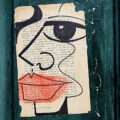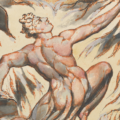Antic Panoply: The New Arcana
In The Art of Recklessness, Dean Young brings New York School surrealism into new relief. He talks of a poetry that contains the kind of stage-spanning acrobatic leaps you might have seen in vaudeville a century ago, or in balletic parodies performed by out-sized, operatic personae fluent in various arcane argots: at times witty, other times ludicrous, often madcap, always comic. The New Arcana, a collaboration of poets / artists John Amen and Daniel Y. Harris, demonstrates exactly the kind of reckless logic, syntax, and imagination that Young describes.
The book is a wildly antic collage of dramatic scenes, verse, diary and yearbook entries, phrases in Hebrew, clip art, illustrations, snapshots, and doctored photographs. Amen’s interest in alchemy goes back at least as far as his earlier book, At the Threshold of Alchemy, while Daniel Y. Harris’s immersion in the Kabbalah of Jewish mysticism underpins his book, Paul Celan and the Messiah’s Broken Levered Tongue, selected by the Jewish Daily Forward as one of the most important Jewish poetry books of 2010.
In the first darkly comic “Section I,” we meet Jughead Jones and the flighty, unfaithful Sadie Shorthand who, like university students in every generation, sit in cafes and alternately discuss the nature of reality and their “fluttering day.” Here’s Sadie:
“Who I am essentially is always three steps ahead of who I am incidentally,” Sadie replied. “Even you, Mr. Don Juan, are an illusion.”
“’Touche,’ conceded Jughead and tucked a $20 bill into Sadie’s g-string.” Added to the narration are various artifacts or documents, submitted as if in evidence in a court of law, as the transcript of a radio show, or in mimicry of a graphic novel. The text, for example, quotes Sadie’s senior yearbook: “To be God—now that’s a strong karma” and includes clip art of a corset next to a fanged reptile. Tangential or irrelevant items—like a photo of aging parents—trail the characters. Jughead and Sadie are, at the outset, madly in love. A character referred to as “I” or “I and I” enters the scene rather like the Stage Manager in Our Town, and comments on the lovers:
Infatuation glows like a right angle––
Beware the bare, eroded slope of Eros.
Inevitably, discord occurs between the lovers. In Act III, Jughead sits alone in the café. In Act IV, more discord. “You really need to figure out what’s next for you, Sadie./ Math, theology, whatever. Why don’t you put out a book?” Jughead quips. Sadie responds, “Well, Jug, the truth is, you’re my first book. /I’ve been editing you since we met.” In Act V, Jughead is outside Sadie’s apartment, under the eave, watching her, “sketching in his resentment pad.”
The romance ends badly. Actions and interactions appear to be intentionally senseless. The text parodies and mocks literary prizes, adult chat rooms, and breast-feeding. Illogical documents appear: Austin Halford’s text on the Dark Ages and the Renaissance of Literary Insurgence is quoted in Act II. Enrico the Insouciant’s irrational equations appear in Act VI, where Yolanda the Crone eats a kefir and tofu sandwich. Following a detailed list of the cluttered contents of his apartment, one Eidenberry Whatever dies while wearing his adult diapers. (“I wish I’da met him when our parts was still workin’,” says Jacqueline the Mum, an ancient rock bank musician.)
Section Two continues a legal theme with a Judge and Lead Advocate Hortense, as well as other odd Dramatis Personae, like Constance Carbuncle, Justin Nurm, Dr. Yistrum Lee, Bus Driver, Don the Commuter, Freddie Brill or Sir Adrian the Fop-Murderer, and Thaddeus Felino. Section Three plays out a theme hinted at in Section One: the absurdity of artistic and literary striving and fame is demonstrated in portraits of six wacky artists, many prodigies, all coming to no good.
Klaus Krystog de Moliva combines an interest in music with toxicology. The poet-prodigy Ann Chuong-Sandrik dies at 29 by auto-asphyxiation. Marvin Fegley Waife, famous for “semen” poems first written when he was 11, and author of vaginal sestinas and lacteal villanelles, dies of heart failure at 20. Sally Pixton, began her critical essay on Thomas Carlyle, when she was 11, published her first book at age 13, graduated from Harvard at 14—well, you get the idea. She is dead at 28 of snakebite. The only one in the pantheon not dead, it seems is Marguerita Voeckers De Winter, a recluse whose photo remarkably resembles the photo of the poet John Amen. (So if she, being a recluse, is dead, we might not know.) In deliberate obfuscation, the pagination of this part of the book wavers back and forth between “Section Two” and “Section Three.” Where are we really?
Amen and Harris regularly wander into lexicography and malapropism, engaging in theological discussions of the Creator, “the Premier Cause, […] shondly [sic] beyond reproach”; enlisting dozens of poisons, from pesticides to biocides, as actors in the drama; and inventing delicious words like sluther, preffy, ran-moral, sufferal, anthroid sufferal, axan, de-terra, and so on. Here’s another sample:
In sucal yoifs, sufferal in exspansion may randily be an effecting of the Premier Cause’s sal-wiring or auto-mandalated karmica.
Interspersed with this nonsense are passages of lyric clarity: “My doppelganger and I now sport interchangeable heads.”
The fifth and final section consists of twenty wonderful seven-line cantos that conjure Eliot’s Prufrock and Stevens’ guitarist, but written in country slang and revolving around the life of one ordinary stereo salesman named JD who “strum [sic] his red guitar as sunrise/drape over the house.” He “skim [sic] headlines […]/ consider [sic] a sick day, sick with success and failure.” Gritty, evocative verses are hidden like gems in the pockets of this text. America of the 1980s, for Amen and Harris, is a matter of “revolving doors [that] spin like a dervish, diner grills steaming with cheeseburgers, steaks, eggs, French fries; ice cream scoops are blazing, cash registers chiming; intercom voices bellowing discount deals in strip malls, casinos, convenience stores [. . .]” They create a portrait of the American temperament and cast of mind that resonates with our current national malaise and depression:
dollar bills sucked into vending machines, credit cards flashing, fives and tens and twenties whisked from wallets and purses, the I want I want of ten million shrieking souls determined to have fun have fun
This is heady stuff. In the metaphor of the book’s title—obliquely referencing James Merrill’s occult communications with angels and spirits in his epic narrative, The Changing Light at Sandover—The New Arcana deals mixed genres and mysterious (not to say weird) significances, dramatis personae, dialogue, stage directions, and a panoply of visual props. It presents a vat of comic madness into which riffs, visual imagery, collages and much else have been mischievously stirred.
About Zara Raab
Zara Raab's most recent books are Rumpelstiltskin, or What's in a Name? (Finishing Line Press) and Fracas & Asylum (David Robert Books, 2013). She lives in western Massachusetts. Visit her at http://www.zararaab.com.






